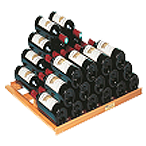Wine & Food Pairings
Great wine and food pairings can make their enjoyment together dramatically better than alone.
Following simple pairing rules may be enough for many people but getting to truly great pairings takes more effort. Fortunately, we’ve captured the pairing skills of our BottleCru expert sommeliers into a simple-to-use online tool!
Try it now! What foods are you having?

Taking your food and wine pairings from good to great!
Great pairings are not easy. This is because it is not just the base ingredients/protein of a meal (e.g. beef) but how the food is cooked, and what sauces, seasonings or garnishes are added that determine the best wine parings.
Wine style, not just the grapes it’s made from, defines the overall aroma, taste and texture and how it pairs with foods. For example, all Chardonnays do not pair the same. Their acidity, aromas, taste profiles and perceived weight on the palate can be quite different. There are dramatic differences in paring an Oaky Napa Chardonnay, a Burgundy White and a French Chablis. They taste and interact with foods in dramatically different ways.
BottleCru is the only app that helps you discover your favorite styles of each wine type, going beyond broad categories or social averaging to get to the core of your personal palate preferences.
Now there are “rules of thumb” that can be applied to making successful pairings, but they must be applied with some considerable care. But using our guide can help lead you to determine the best pairings for your food and wine and provide a more satisfying experience.
So you want to try to create great pairings yourself? Here are a short useful set of guidelines to get started.
Guidelines for Great Food & Wine Pairing
- Consider how the food was prepared and what sauces, seasonings and cooking techniques were employed.
- Consider wines that you enjoy on a stand-alone basis as undoubtly it will be tasted on its own before the food is eaten. The wine will enhance the food but it’s a bad start if you don’t enjoy it stand-alone.
- Select a wine that will match the flavor intensity of the food. If either is much more intensely flavored it will dominate the pairing and overwhelm the other.
- The wine should have at least the same level of acidity as the food or the wine will be perceived as non-palate cleansing between food bites.
- Select a wine about the same perceived weight on the palate as the food or it will dominate the food.
- Matching “like with like” (flavor intensity, weight, acidity) creates a harmony between them and an improved experience.
More Details
- If the meal is salty then insure than a red wine is lower in tannins as salt enhances tannins and salt tends to decrease the perceived acidity in wines.
- Roasted, fried or grilled foods generally pair well with oak-aged flavored wines.
- Foods with sweetness or pronounced fruitiness are best paired with wines that are perceived as fruity or slightly sweet (off-dry) or the wine will be perceived as flat as life-less. Slightly off-dry white wines are best. For dessert dishes insure the wine is sweeter!
- Foods with high umami character are best paired with higher acid, lower tannin wines, potentially with their own earthiness. Pinot Noir is the classic selection.
- Don’t pair spicy foods with high alcohol wines as they will accentuate each other out of balance.
- Foods with a lot of butter or animal fat reduce the perception of tannin in red wines.
- Foods with significant Fish Oil are best matched with dry, high acid white wines or sparkling wine, avoid red wine.
- Cooking methods will affect the flavor intensity. For example, grilling adds more flavor than steaming. Raw, cold or less seasoned foods have less flavor intensity.
- If a food is very spicy, tangy, or herbal it can dominate the wine. Likewise, if a wine is too powerful or tannic it will overwhelm a delicate dish.
- Color is often a hint to flavor intensive, both in food and wine.
- Food weight perception is dominated by fat, oil content and protein density. Wine weight is heavily influenced by the level of alcohol, i.e. higher alcohol wines are heavier on the palate.
- Oak aging makes a wine heavier on the palate.
- Generally lower alcohol wines are more food friendly, and white and rose wines are generally lighter weight.
Matching sweet wines with sweet desserts
The cardinal rule of pairing sweet wine with sweet food is that the wine must be as sweet as or sweeter than the food or it will taste sour and unappealing. The chart below shows our suggested wines, their origin and for some their [grapes] and some suggested dessert pairings.
Sweet Wine Type |
Some Suggested Dessert Pairings |
|---|---|
| Sweeter Sparklers | Best serving temperature 43-50⁰ |
| Sparkling wines: Extra dry, demi-sec, California | Cherries & Cherry Desserts, Cup cakes, Berries |
| Champagne: Extra dry, demi-sec or doux, France | White Chocolate, Berries, Poached fruit, Fruit & yogurt-based desserts |
| Asti Spumante & Moscato d’Asti Italy [Muscat] | White fruit-based desserts, Frosted cup cakes |
| Branchetto d’Acqui, Piedmont Italy [Branchetto] | Chocolate , Dark berry jam, Cherries & strawberry desserts |
| Sweet Late Harvest Wines | Best serving temperature 45-50⁰ |
| [Riesling, Gewürztraminer] “Vendange Tardive” (off-dry) & “Selection des grains nobles” (sweet), Alsace France | Cheese cake, Custard pudding, Crème Brulee, Crème Caramel, Apple pie, Frosted cup cakes, vanilla ice cream |
| White Late Harvest, “Australia [Semillon & Muscat] | Custard pudding, Crème Brulee, Crème Caramel, Apple pie |
| Sauternes & Barsac, Bordeaux France [Semillon & Sauvignon Blanc, Muscadelle] | Custard pudding, Crème Brulee, Crème Caramel, Apple pie, Candied fruit, Apples, Pears |
| Vouvray, Bonnezeaux & Coteaux du Layon & Montlouis & Quarts-de-Chaume, demi-sec or doux, France Loire Valley [Chenin Blanc] | Peaches, Pear & apple tarts, Crème Brulee, Crème Caramel, honey |
| Tokay, Hungary [Fermint & Harslevelu] | Chocolate filled crepes, Apricot cake, Nut based desserts |
| [Riesling] Auslese & Beerenauslese (BA) & Trokenbeerenauslese (TBA), Germany | Cheese cake, Custard pudding, Crème Brulee, Crème Caramel, Apple pie, Frosted cup cakes |
| Eiswein, Germany, Austria, [Riesling] Canada, upstate New York [Riesling & Vidal Blanc] | Apple pie, Peaches & Pear tarts |
| Recioto di Soave, Veneto, Italy [Corvina, Rondinella, Molinara] | Nut based desserts, Orange custards and mousse desserts |
| Recioto della Valpolicella, N. Italy, [Corvina,Rondinella, Molinara] | Cherries & strawberry Desserts, Chocolate, Dark berry jam |
| Vin Santo, Tuscany, Italy [Malvasia, Grechetto & Trebbiano] | Biscotti cookies, Nut based desserts |
| Sweet Fortified Wines | Best serving temperature 64-68⁰ |
| Port: Vintage, Late Bottled Vintage, Portugal | Chocolate (Bittersweet or Semi-sweet), Chocolate custard, Coffee and caramel flavored desserts |
| Port: Tawny Port, Portugal | Chocolate, Caramel, butterscotch and toffee flavored deserts |
| Sherries: Sweeter Olorosos & Cream Sherries, Spain | Chocolate , Coffee, Crème brulee, Crème caramel |
| Madeira: Bual & Malmsey, Portugal | Chocolate, Crème Brulee, Crème Caramel, Frosted cupcakes, Citrus fruits |
| Light, Vin Doux Naturel (VDN):Beaumes de Venise, France [Muscat] | Chocolate (Milk/Sweet), Chocolate (White), Cheese cake, Coffee flavored desserts |
| Dark, Vin Doux Naturel (VDN):Banyuls, Rasteau, France [Grenache] | Chocolate, Chocolate (Bittersweet or Semi-sweet), Coffee flavored desserts |
| Muscat & Tokays, Victoria, Australia [Late harvested Muscat & Muscadelle] “Stickies” | Chocolate, Chocolate (Bittersweet or Semi-sweet), Coffee flavored desserts, cream-based deserts, Dried fruits (stone fruits) |
| Port Style Wines, CA[Zinfandel] & Australia [Shiraz, Mouvedre & Grenache] | Chocolate (Bittersweet or Semi-sweet), Chocolate custard, Coffee and caramel flavored desserts |
Had enough complexity?
Then leverage the thousands of great pairings created by professional trained chef/somms with the BottleCru web-app. Here is a shortcut to go directly to the Wine and Food Pairing section of the app.
BTW. Trying to pair two different dishes or meals with one wine selection? No problem…We’ve got you covered. The app can pair two different meals!
Enjoy!!






